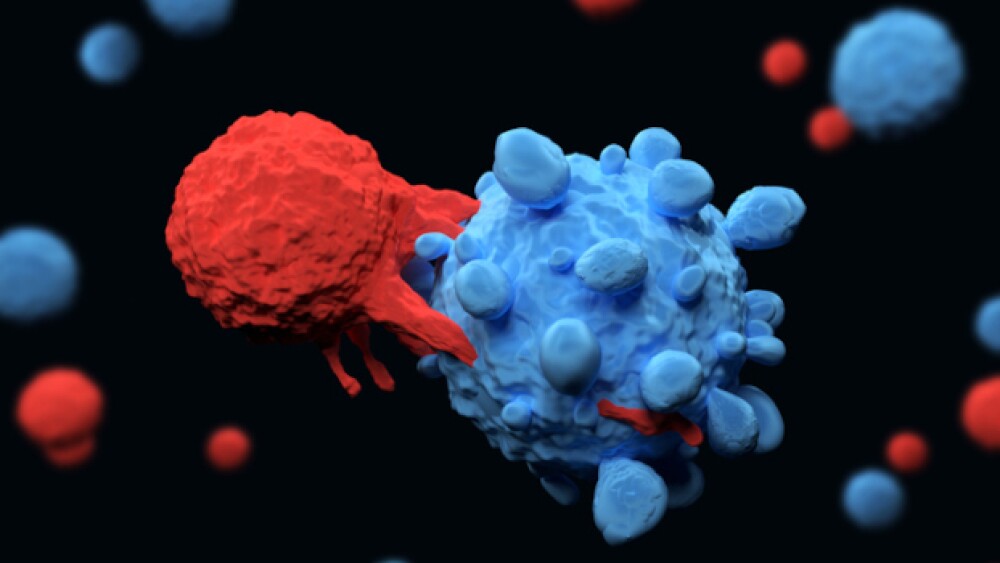Cell and gene therapy represents the most promising breakthrough in cancer treatment for decades, but it comes with a hefty price tag. Here’s how to drive costs down.
Pictured: Illustration of a T cell killing a cancer cell/iStock, Meletios Verras
Cell and gene therapy represents the most promising cancer treatment breakthrough in decades. One study found that CAR T cell therapy helped put 58 percent of patients with relapsed and/or refractory(R/R) B cell lymphoma or chronic lymphocytic leukemia into remission, with 76 percent of those patients remaining in long-term remission. Patients also don’t have to contend with the unpleasant side effects associated with traditional chemotherapy treatments. Until recently, patients had to make do with treatments with far lower efficacy and greater safety concerns. If they didn’t respond to those more traditional treatments, they were left with few options. Although CAR T cell therapy doesn’t work for all patients, cell therapy could cause a leap in human health and life expectancy akin to when antibiotics were discovered.
With every year, more cell and gene therapies enter clinical trials. Thousands more are at various stages of clinical trials throughout the world. The FDA this year created a super office to process the flood of new therapies, the Office of Therapeutic Products (OTP).
An Emerging Accessibility Crisis
The fact that cell therapy looks so transformational makes it even more urgent to work to enable affordable treatments for patients. Cell and gene therapies remain prohibitively expensive; CAR T cell therapy, for example, can cost over $500,000 for a single treatment.
Payers such as private healthcare providers, Medicare and Medicaid may not be able or willing to cover the expense of current or pending cell therapies. When not insured, the challenge for patients in accessing these treatments is even greater. Resource-limited countries without complex infrastructure or adequate funding will face challenges in providing cell and gene therapy to their citizens, contributing to global health inequality.
The current therapeutic costs arise from the intensive manufacturing processes and materials needed, so the greatest savings can be achieved by reducing labor, automating and streamlining processes. In simple terms, cell therapies involve changing genetic material within cells to correct problems or provide useful new functions. Therapies like CAR T cell therapy involve editing T cells (the lymphocytes that find and destroy defective cells) to recognize and target a specific antigen on cancer cells. Removing cells from the body, editing their genetic information and infusing them back into the bloodstream is extremely labor-intensive and time-consuming.
Innovations That Will Drive Costs Down
There are two main types of therapies that use engineered cells to treat cancer: autologous therapy—which uses a patient’s own immune system to treat their cancer—and allogeneic therapy, which draws from donor materials to generate many off-the-shelf therapeutic doses.
Allogeneic therapies are expected to massively reduce costs by scaling up the number of doses that can be manufactured from a single donor. The cost savings and accessibility of this approach are a result of simple economies of scale. However, while promising, few allogeneic therapies have received FDA approval.
Autologous therapies, on the other hand, are personalized to individual patients. Autologous therapies are likely here to stay, given their track record of curing certain cancers and having several FDA approvals already in place. But autologous therapeutics have to be made one patient at a time, which is a major driver in the cost of therapy.
Manufacturing costs for CAR T cell therapy can be roughly divided into three types. First, the vectors for transduction used to genetically modify T cells to express chimeric antigen receptors (CARs) are expensive, making up around a third of the total manufacturing cost. Labor is another major cost, and components such as manufacturing materials and reagents, facility overhead and quality control make up the final category. Transduction is the most cost-intensive step of the manufacturing process because it includes vectors, a portion of the overall labor, and a portion of the other components.
Against a backdrop of growing patient demand, prohibitive costs and long treatment wait times, companies are working to resolve many issues that are keeping costs high. For example, they are devising new ways of automating processes to reduce labor costs, combatting the current supply shortage of cells from patients and working to scale up production of GMP-grade reagents to bring down long delivery times. In addition, new providers are entering the market, bringing more diversity to reagent providers, and companies are working to increase retroviral vector capacity.
While scale, automation and cost savings can be implemented at each stage of the manufacturing process, a few key steps where such improvements can be made include isolating T cells from other cells, activating them and growing enough cells for eventual patient administration. With the number of steps in the manufacturing process, new entrants and fresh technology are bringing about increasingly efficient ways to improve the yield of T cells and at larger scales.
For example, for decades, cell separation has occurred via magnetic-activated cell sorting (MACS). However, isolating cells using magnets has its limitations. MACS relies on complicated and costly equipment, the magnetic workflows are damaging to cells and the magnets themselves can be damaging to the environment. Perhaps most problematic of all, MACS platforms are inflexible and extremely difficult to scale up, making it time-consuming and costly to separate the high volume of cells required to meet the increasing demand of cell therapy.
New ways of separating cells are cutting down on complexity, labor requirements and costs. For example, my company, Akadeum, is a pioneer in microbubble-based cell separation—referred to as buoyancy-activated cell sorting (BACS)—a technology that has disrupted MACS. BACS uses microscopic air-filled silica-shelled hollow microspheres to separate high-value biological targets from non-target cells. Microbubbles, using negative selection, positive selection and depletion, use their buoyancy to float desired or undesired cell populations to the top of a solution where they can be removed or transferred to the next operational step. T cells are gently isolated and removed, leaving target cells healthy and non-exhausted before patient administration. Not only is the process gentle, but the processing of billions of cells with microbubble-based protocols can be completed in an hour and multiple donor samples can be processed simultaneously.
Companies are also exploring how cell therapy production can be scaled up—for example, by automating various stages of the transduction process, using instruments and robotics to reduce labor costs and minimize human error. CDMOs are also increasing their use of data analytics to monitor and control cell growth conditions and reduce the time needed for quality control. Scalability is further boosted by the rise of parallel processing, with multiple batches run at once to meet increased demand. With the rise of AI, these tools are becoming ever more powerful.
These iterative improvements follow a common pattern for the many cutting-edge innovations: These types of new technologies can be expensive and inaccessible at first and made more affordable over years of new innovation and discovery. For instance, when commercial air travel first arrived, it was so expensive that only the wealthy could afford it. Now, airline operations are so efficient, operating at such scale, that air travel has become affordable for many people. My hope is that cell and gene therapy is on a similar path, bringing the promise of curative therapies to the masses.
Brandon H. McNaughton, PhD, is the chief executive officer and co-founder of Akadeum. He can be reached at info@akadeum.com.





